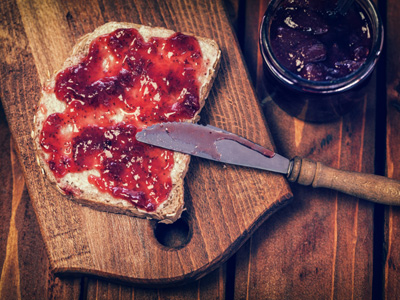
Toast and jam - a firm favourite in Britain.
What's cooking?
Test your English vocabulary about food in this 'What's cooking' quiz!
Someone once said that 'the English eat to live, but the French live to eat'. For a long while Britain held lots of power in the wider world despite her food being both varied (what with imports from all round the globe), yet somehow also despised (particularly by Europeans who believed it was monotonous).
Anyway, nowadays British food in general is healthy and varied and welcomes the best of many other traditions from Europe, the Commonwealth and further afield. It's not all just fish-&-chips and curries!
Answer 1 are all herbs, Answer 3 are 'table birds' in various sizes, and Answer 4 are all from the spice rack.
The overall sequence would probably be: Thaw ( = remove from freezer and allow to come to room temperature) ; wash / rinse ; chop/slice (and/or, perhaps, 'peel') ; heat (and/or 'boil') ; stir (and possibly 'cover and simmer', i.e. once it's boiled or boiling, you can leave it to continue cooking at that temperature) ; season ( = add flavourings, perhaps such as in Question 3, unless this was done earlier) ; drain ( = pour off the water once cooking has finished) ; slice ( = chop up the whole thing into portions before serving, as with a pie or a large joint of meat) ; decorate ( = garnish) ; serve. There are of course many other more specialised terms (grate, sprinkle, add, reduce etc.) but this sequence of a dozen or so should get you well on your way!
You would find vinegar fairly freely available in places that specialised in fried and/or grilled food (eg burger and chips, and similar), along ~ probably ~ with 'brown sauce'.
Worcester sauce is unlikely to be left on tables, but may well be offered at the bar or serving point to spice up a glass of tomato juice.
You may well come across 'game pie' (i.e. containing the meat of birds or animals that have been hunted in open country), pork pie (with or without hard-boiled eggs inside it: 'gala pie') and even 'fish pie' (so-called; but the topping is much more usually done with mashed or sliced potato, like a 'cottage pie' ~ with minced meat, and perhaps some vegetables included ~ or 'shepherd's pie', which unsurprisingly would be made with sheep-meat [mutton or lamb]). Anything approaching a 'cheese pie' would more likely be known as a savoury flan or quiche.
All in all, a savoury tart (as such) would be possible but very, very unlikely ~ so Answer 4 is the one with the falsehood in it.
Tea (also from India, and/or China) and the sandwich (named after the Earl of Sandwich, who asked his servants to devise a meal that could be eaten straight off the plate with one's bare hands, so as not to interfere with a session at the gambling table) are both very British by long adoption. There is also the Cream Tea ( = tea + fresh scones with clotted cream or butter, and fruit jam).
Apple Pie meanwhile is sometimes quoted as essentially American, but we may find that questionable. The Dutch (in Holland/the Netherlands), among many others, were surely baking apple pies some while before European settlers established orchards in New England; meanwhile we doubt whether the aboriginals of North America (once, wrongly, known as 'Indians') were familiar with apple pie.
Here are lists of shopping in four people's supermarket baskets. Which of these would you say is probably the healthiest in terms of being fresh, locally-sourced (probably/potentially) and free from additives?
In Answer 1, all the items for this apparent upcoming children's party consist of 'processed food' in one form or another: nothing fresh at all.
Answer 3 includes items from far away (bananas; food-miles again!), refined sugar, squash which almost certainly contains added ingredients such as flavourings, preservatives and 'acidity regulators', and two processed meat items. Kippers are smoked herrings, which according to some sources may slightly increase the risk of cancer (although many people find them delicious).
Answer 4 contains several further processed items; the 'economy chicken' was probably reared in a battery unit and nothing else is fresh. One might hope the people would at least be buying fresh vegetables ... !
All these other pairings are either long- or firmly established, or both; and if you haven't tried them, maybe you should! (Subject to availability, and your own dietary restrictions, of course.)
Ready for more?
not all...
quizzers. Try to win a coveted spot on our Hall of Fame Page.








If you were thinking of 'eggs that had been beaten (or even whipped) and mixed-up out of their original shape', you meant 'scrambled' or possibly an omelette.
In theory one might try to batter an egg, but this sounds rather a strange thing to do and probably wouldn't be worth the effort in terms of producing something tasty. This may well be why it's never offered!
The other three ways of serving eggs at breakfast are very normal, along with poached and as an omelette.